This week’s New Yorker has a wonderful Calvin Thompkins story about Thai artist Rirkrit Tiravanija. Unfortunately you can’t read the piece online but it’s a great read full of background about the artist and juicy insider info like the fact that the artist was married for a short while to artist Elizabeth Peyton. They’re not married anymore and are in fact married to other people but Peyton and Rirkrit remain friends according to Thompkins who quotes Peyton extensively in the article.
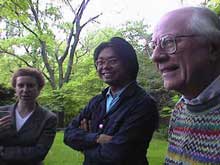
I mention all this because the artist has a few Philadelphia connections. And also because I did an interview with him back in April, 2002, when he was in Philadelphia as part of a Fabric Workshop group exhibit curated by Ellen Lupton* of the Cooper-Hewitt Design Museum. The show was about shelter in the age of disaster and it was a marvelous design/art show.
Rirkrit’s piece was a pup tent that folded up into a jacket — it was a prototype for an edition. The artist gave a lecture that I attended and beforehand I had a few minutes to interview him. He’s an easy person to talk to, very forthcoming. I wrote up the piece as a Q&A for artnet where the piece ran in April, 2002. Here’s the link. And below is an excerpted copy with a few extra pictures.
Spiritual Comfort
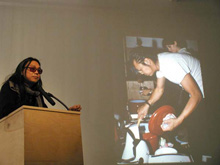
We caught up recently with Thai artist Rirkrit Tiravanija in Philadelphia before he gave a talk at the Fabric Workshop and Museum (FWM). Tiravanija, 41, an associate professor at Columbia University’s School of the Arts, has new work in the FWM’s “Comfort Zone” exhibition. The show, which is on view till Apr. 21, (2002), was organized by Ellen Lupton and includes fabric-based structures by ten artists.
Tiravanija’s piece, a pup tent attached to a jacket, is a kind of wearable, portable shelter and a prototype for an edition of multiples he may do as a project at the FWM. The tent conjures up thoughts of homelessness and nomadic existence. We asked Tiravanija, who divides his time between New York, Europe and Thailand, about his own peripatetic life. “I like to say that my home is where I am at the moment,” he said, laughing. “I’m content where I am. It’s Buddhist thinking.” (image is Rirkrit talking at the FWM in 2002 about one of his cooking pieces.)
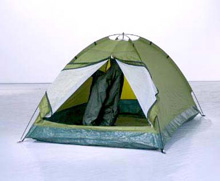
“Buddhist thinking” explains a lot about Tiravanija’s projects, which are a mix of cooking, travel, sleep, talk and housing — all based on the idea of injecting life into art. Tiravanija, who went to art school in Toronto but thinks of himself as self-taught or “peer-taught,” spoke easily about his life and his art. (image is the pup tent/jacket)
RF: You just came back from Thailand but before that you were in Germany. Where did you experience the events of September 11?
RT: I was in Thailand and in fact I was just about to fly from Bangkok to Berlin. So I’m watching it happen (on television) and arriving at the airport. And CNN, to me, has become a kind of great distancing. But coming back to New York and sitting down with a friend and having a drink and listening to his experience of standing on his roof. . . it was very different. And I felt like I missed an experience, a communal situation. But being Thai or Buddhistic and coming from that culture, death and destruction and change are daily. They’re going on all the time, and it’s a part of your daily life. And so, you take it as “air,” in a sense.
RF: Have you been to Ground Zero?
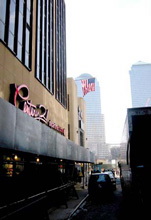
RT: I haven’t been to Ground Zero and I don’t like to be a tourist. The World Trade Center was never my favorite building so I didn’t have a relationship to it as a kind of place or space or object. But I had a great relationship to a department store called Century 21, which is next door. Now the store is back, and that’s New York for me. They go right back in there and put the socks back on the shelves, and we’ll all go there next week and buy socks. A friend was telling me about going to Century 21 and looking out the window and seeing Ground Zero. And I said, yeah, I think that would be my kind of experience of Ground Zero. Rather than to go to the platform and look out, you experience it as part of your daily routine, not like a kind of spectacle. That’s always quite important for me. The world is experienced as part of daily life and not as a spectacle.
(image is Century 21 facing Ground Zero in a shot taken in April, 2002)
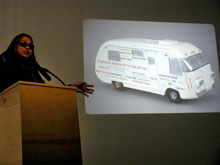
RF: Let’s talk about your tent in “Comfort Zone.”
RT: The idea of comfort is always interesting. Comfort is not what we think — a plush, cushy space. Comfort is a spiritual thing. You can have comfort with very little and I think that’s something not everybody realizes. This tent is very minimal, very light, very unassuming. But it gives you a degree of both public and private. And it’s like having a home but not having property. Being in New York in the 1980s, I lived next to Tompkins Square Park, which was a really vital ground where homelessness and anarchism and anarchistic structures were developing. And I was thinking about that a lot. This particular structure is made to be functional. Everything I make, even as a discrete object, is meant to be used. This is a prototype made in Thailand. (image is Rirkrit with a slide of the airstream trailer that was part of his “On the Road” project from 1998 sponsored by the Philadelphia Museum of Art)
RF: I read you were in a band and made music. Do you still do this?
RT: Yes, but no particular aims or goals, more of an activity, again, with a lot of people. As for the kind of music I make? Generally. . . noise, and I would not qualify it as music. I listen to music — everything. I have no expectations, I just like good content and good music. At the moment, I’m listening to Willy Nelson’s Stardust.
RF: You have said your art is a kind of critique of Western institutional practices. When you go to a museum, what do you find yourself looking at most?
RT: Out the windows. I like 1950s Fluxus and ’60s Conceptualism, but mainly I look out the windows.
(top image is the artist in Philadelphia, flanked by then-PMA curator Ann Temkin on the left and an unidentified man. This was at the end of the PMA-sponsored project, “On the Road” in which the artist and three Thai students travelled the USA pulling an airstream trailer in which they lived. The 1998 project was an early PEI-funded outside the box initiative.)
*(Lupton and Abbott Miller, by the way, are guest-curating a new group show for the FWM. “Swarm,” opening Dec. 2 is about the concept of emergence.)
tiravanija, rirkrit









